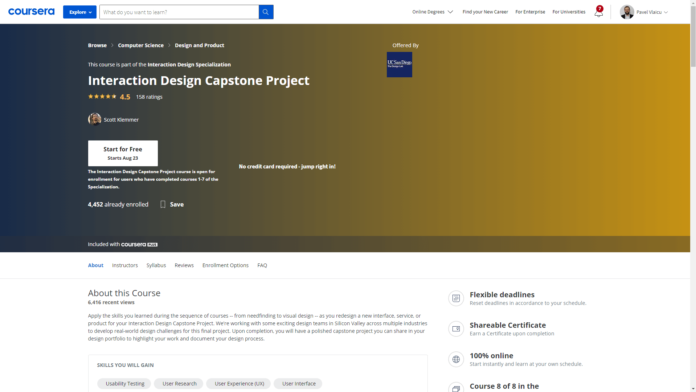About this Course
Apply the skills you learned during the sequence of courses — from needfinding to visual design — as you redesign a new interface, service, or product for your Interaction Design Capstone Project. We’re working with some exciting design teams in Silicon Valley across multiple industries to develop real-world design challenges for this final project. Upon completion, you will have a polished capstone project you can share in your design portfolio to highlight your work and document your design process.
Instructors
Scott Klemmer
Professor
Cognitive Science & Computer Science
Offered by
University of California San Diego
UC San Diego is an academic powerhouse and economic engine, recognized as one of the top 10 public universities by U.S. News and World Report. Innovation is central to who we are and what we do. Here, students learn that knowledge isn’t just acquired in the classroom—life is their laboratory.
Syllabus – What you will learn from this course
Week 1
Design Thinking Capstone
Welcome to the Interaction Design Capstone Project!
Week 2
Needfinding
As Yogi Berra said, you can observe a lot just by watching. Watching how people do things is a great way to learn their goals and values, and come up with design insight. We call this needfinding. This module trains your eyes and ears to come up with user needs, breakdowns, clever hacks, and opportunities for improvement.
Week 3
Ideation
To maximize your chances of having a great idea, it helps to generate a lot of ideas. Brainstorming is a strategy for rapidly generating lots of ideas. It was named by advertising executive Alex Osborn in his 1953 book, Applied Imagination. When brainstorming, go for volume and defer judgment. Often, something that seems like a crazy idea can lead to something that’s a really good idea. Immerse yourself: it can help to use a whiteboard, butcher paper, or stick post-its on a wall. These ideas will become the ‘soil’ for growing your designs.
Week 4
Prototype
Prototyping is the pivotal activity that structures innovation, collaboration, and creativity in design. Prototyping gets ideas out of your head and into the world. Like a conversation, your ideas will evolve as you articulate them and make them concrete. Prototypes are quick and dirty, not careful museum pieces. The key to prototyping is to jump right in. It’s a tool to see what’s working, what challenges emerge, and to share your ideas with others. Review the user needs you brainstormed. In this assignment, you will flesh out your design ideas by storyboarding and making paper prototypes.
Week 5
Design Heuristics
Design can succeed (or fail) in many ways. That said, there are common heuristics that will get you on the right path. In this module, you will conduct heuristic evaluations (HEs) of another learner’s paper prototype. The heuristic evaluations will be a way to highlight usability issues, and think about how to improve them.
Week 6
A Plan & a Skeleton
A journey of a thousand miles begins with a single step. Figuring out what that first step is–and then what the one after that is–can be especially daunting with creative projects. Making forward progress is a lot easier if you write down concrete, actionable goals. This is the main benefit of a development plan. A development plan also helps you track momentum. Are things progressing at the pace you expected? Faster? Slower? Writing a time estimate into your plan and tracking how long it actually took helps you gauge your pace. The first steps of your plan should be the skeleton that forms the core screens of your design.
Week 7
Ready for Testing
Crunch time! Your interactive prototypes have to be ready for user testing by the end of this assignment.
Week 8
Test your prototype
In this assignment, you will test your prototype in person with two people to find usability bugs & potential improvements.
Week9
Results!
You’ve got data from online users that compares two alternatives. How can you tell whether there is a real difference? Statistical tests, like the CHI-squared test, tell you whether the behavior you observed was likely to have occurred by chance, or whether there’s likely to be a real difference between the designs. A/B experiments like these are becoming increasingly popular in industry because experiments help you test your assumptions.
Week 10
Show & Tell
You’ve done all this great work, and your hard effort has paid off. You’ve brainstormed, prototyped, designed, iterated, refined, and evaluated. Now’s your chance to share your work with the world. This is a great opportunity to tell your design story, and use it as a portfolio to impress your friends, family, and potential employers.
